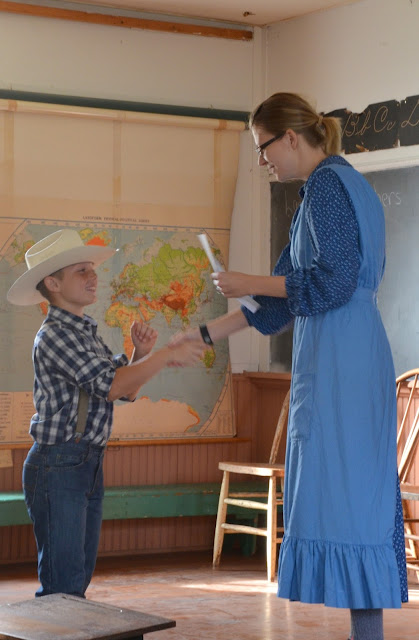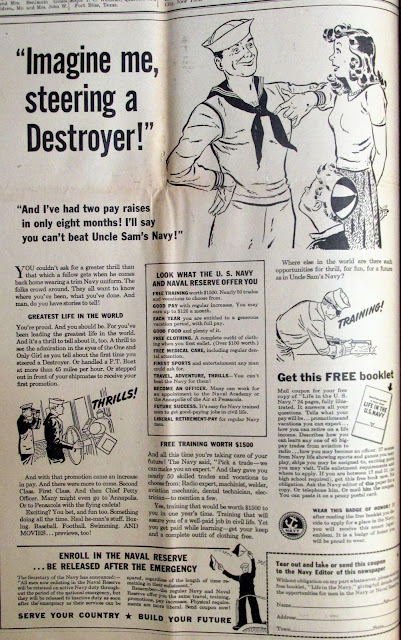We’re
going to look at life in 1890 this month, life in Sutton, in Nebraska and
beyond.
The
Sutton Museum received several items from the estate of Jim Griess including
copies of very early Sutton Register newspapers. We’ll tap into one of those
now. The bound volume contains all 52 issues of the Register in that year, four
pages per issue – a good resource.
1890
was the fourth year that F. M. Brown had been publishing The Sutton Register.
He and his son Charles would operate that paper through the 1930’s.
 |
Register publisher F. M. Brown had a joint subscription offer
with the Detroit Free Press. How'd that happen?
|
Benjamin
Harrison was president in 1890. His was a one-term presidency between the two
terms of Grover Cleveland – the only time that has happened to us. His
grandfather was the ninth president, barely, dying just 31 days into his term.
The
governor of Nebraska was John Milton Thayer, a Civil War general who had
organized the 1st Nebraska Infantry Regiment and later switched to
the cavalry.
Some
tidbits from early in the year included:
The Sutton Post Office was moved to the
north end of town, likely where it was within the memory of many off us, next
to City State Bank (Cornerstone to the young folk.)
Roy Clark and Rubben Schwab sold
subscriptions to purchase a flag for the school – delivered with much
celebration.
County Treasurer B. H. Dunn sold his farm
three miles west of Saronville along with 26 horses, 89 head of cattle and 60
stock hogs.
The Sutton Building and Improvement
Company, owner of the Opera House was upset that their insurance rates were 60%
higher that the folks in the Central Block, I. N. Clark was an investor and he
was sure their taxes were higher that other downtown businesses. The Opera
House was also assessed $10 a year for a license to operate. They were looking
to lease the building much of the year.
Clay and Thayer County undertakers formed
a professional society with George Honey as the president.
Mr. I. N. Clark planned to put up 5,000
tons of ice in early 1890 – he was harvesting Glen Lake, now called Clark’s
Pond. This was another family business. Son Albert (Bertie) continued providing
ice for years.
Officers of The First National Bank
(north) were Henry Grosshans, president; George A. Tenny, V.P.; M. L. Luebben,
cashier and Theo. Miller, assistant cashier. Bank capital was $50,000 with
$6,000 surplus.
Directors of the Sutton National Bank
(south) were J. B. Dinsmore, J. J. Bonekemper, A. K. Marsh and Cashier F. C.
Matteson. Their capital was $50,000, surplus $3,500.
 |
The Palace Stables were on the south side of Grove Street. I'm guessing you
could still move that merchandise today.
|
Farmers
were up against some tough economic conditions. Early in the year there were
reports of Pender farmers had stopped moving corn to market at 15 cents a
bushel but were burning it instead of coal at $8 per ton. Ton for ton, corn
generated about the same heat as coal at half the price for soft coal, one
fourth the cost of hard coal. By later in the year, the practice had spread,
widely.
Hastings
authorities began shutting down that town’s bawdy houses.
The
Willow Springs distillery in South Omaha was believed to be among the largest
in the U. S. The owner later was the first investor in the Omaha Stockyards.
Mobs
in the U. S. had executed 175 people during 1889, all were negroes. In 1890
Mississippi authorities executed a white man for killing a black man – the
first time that had happened in the south.
Nellie
Bly landed in San Francisco aboard the steamship Oceanic, took the Southern
Pacific rails to Philadelphia arriving 72 days, 6 hours and 11 minutes after
she’d left on her round-the-world trip. She beat the time of Jules Verne’s
fictional character Phileas Fogg in the book “Around the World in 80 Days.”
There
were eight newspapers in Hastings though a few had failed in the past year but
another was about to start publishing.
The
Goodspeed Publishing Co. released its “Biographical and Historical Memoirs of
Hall, Hamilton, Adams and Clay Counties.”
 |
| Good for what ails ya. |
A
band of Omaha Indians camped on the creek bottom east of Sutton and visited Sioux
Indians who were “on exhibition” at the Opera House. The Sioux were part of The
Kickapoo Indian Medicine Co. staying for two weeks offering free consultation
and advice from Indian doctors before moving on to new hunting grounds. Check
out http://www.bottlebooks.com/kickapoo.htm for further info. Open question: was the
patent medicine company using the Sioux, or the other way around?
Rail
service for Sutton was robust. The Burlington had three trains each way (five
stopped) and the U. P. had two each way. Tickets included 150 pounds of
luggage. Less than 23 hours to Chicago, San Francisco by the third morning and
a weekly sleeper car to Portland in three days (a berth added $3 to the price
of your ticket.)
Sutton
promoters were courting the Kansas City, Wyandotte and Northwestern Railroad to
come through Sutton as they headed northwest out of Beatrice.
Prohibition
was a hot topic with women’s groups and a political party lobbying for complete
elimination of alcoholic beverages in society.
Edgar had gone “dry” in 1889 but two
saloons were planned for ’90.
The Clay County Prohibition Party sent 32
delegates to the state convention.
Harvard prohibitionists accused their
saloons of peddling adulterated liquors. That was also a Carry Nation tactic.
(There’s a bar in San Jose called Carry Nation’s Saloon with a motto,
“Temperance in Moderation” - cute.)
Speakers received up to $100 for speeches
in county towns.
Grafton had a social drinking club with
beer and liquor available only to members – just like Wichita, Kansas when I
was stationed there in the late 1960’s.
Opponents of prohibition offered high license
fees and strict regulation as an alternative.
Thomas Reed, speaker of the US House of
Representatives closed the saloon on his side of the capitol building in D. C. forcing
house members to the senate side.
 |
William Gold began advertising his Close-Out sale on July 4, 1890. He would move to
Lincoln where he first opened The People's Store and later Gold's, the largest department
store in the Capitol City later purchased by Brandeis, the largest operation in the state.
|
These
items appeared in mid-year newspapers:
The Frederick & Wentz clothing store
was in the Merrill building in the Central Block.
P. T. Walton’s confectionary was just
north of Wm. Gold’s dry goods store.
Stevens’ grocery store was one door north
of Grice’s Harness Shop.
The Register charged its competitor
newspaper The Advertiser with bad grammar and articles filled with untruths.
The Hastings Tribune was also no fan of The Advertiser.
Owners of a Fairfield foundry were looking
for a site in Sutton.
Bradshaw was wiped out in a tornado with 6
dead and more than 100 injured. It was described as the “Most destructive storm
to life and property that ever visited Nebraska.”
The 90 remaining Iowa Indians sold their
230,000 acres on the eastern border of Oklahoma for $1.25 an acre. That land
plus more from the Sac, Fox, Pottawatomie and Shawnee was opened in September,
1891. The Oklahoma land rush continuted from April, 1889 through 1907.
A Stockham fellow brought his horse to
Sutton challenging Sutton’s fastest and lost. Significant wagering was
involved. One-on-one horse racing challenges were recurring entertainment.
Much
of the 1890 news involved politics and elections. It took up a lot of space
just to list the contenders. There were the Prohibitionist Party, Farmers
Alliance, Independent Party, a People’s Independent Party and Fusionists. The
Democratic Party was shaking off the stigma of the Confederacy while the
Republican Party of the Union had aligned with Big Business and the railroads
costing them support from farmers. The Farmers Alliance met in Omaha in 1892 to
become the Populist Party. There was a National Reform Party that met in St.
Louis but did not have an impact in Nebraska. A fragmented political picture,
but regardless of party names and affiliations, state issues were still rural
vs. urban.
 |
Dr. Martin Van Buren Clark started his medical practice and a pharmacy in Sutton in 1872. He and his brother Isaac Newton
Clark played a big part in the early development of downtown Sutton, the Clark Addition in the north and west part of town
and in various retail stores. He was the first physician in Sutton and a pioneer in the medical field for the county.
|
The
fall term at Sutton Schools was headed by Prof. Alex Stephens, superintendent;
Miss H. R. Brewer, high school principal; Miss Manis, grammar; Miss Clara Lake,
2nd Intermediate; Miss Evion and Miss Nettie Greer, 1st
Intermediate; Miss Nellie Copsey and Miss Fink, 2nd primary and Miss
Mollie Braun, Miss Stepler and Miss Kittie Hann, 1st primary.
Steel
& Stevens, a Colorado company was buying hundreds of acres of corn, stalks
and all for 5 to 10 dollars an acre in parts of Nebraska. They were building
silos on farms and storing chopped up stalks and corn to feed 7,000 head of
cattle during the upcoming winter. The article did not use the words silage or
ensilage.
And
late in the year, these were some of the items in The Register;
York secured the United Brethren College –
today’s York College.
All Nebraska towns over 1,200 had a water
and fire protection system except Sutton. A special election in September
approved a $16,000 bond calling for a 75-foot water tower in the Fowler
addition – we called it the “standpipe” didn’t we?
A group planned to build the Kansas City
stockyards.
Chicago’s new masonic temple was to be 20
stories tall – 302 feet – the tallest building in the world from 1892 until
1905.
Drought had almost wiped out the corn crop
locally forcing small farmers to sell small pigs, or even take a hammer to
them. F. M. Brown’s comment, “Wanted at this office! A well matured ear of corn
of the vintage of ’90. It will be properly labelled with the producer’s name
and laid away in our collection of rare curiosities.”
The
November general election dominated late-year news.
Sutton voters defeated a prohibition
measure 208-174.
Independent Party candidates McKeighan and
Horn drew the most Sutton votes for US congress and state senate. Independents
won both state representative seats defeating Republicans.
Independent candidate Powers received the
most votes for governor in Sutton but Democrat James Boyd won the post
state-wide. Outgoing governor Thayer refused to relinquish the office on the
grounds that Boyd was not a citizen (he was born in Ireland.) The Nebraska
Supreme Court advised Thayer to step down but later reversed itself after Boyd
served a short time. It was a year before that the US Supreme Court ruled that
Boyd was eligible to be Nebraska’s governor. Thayer had served more than a year
of Boyd’s two-year term.
Sioux
Chief Sitting Bull was killed at the Standing Rock Reservation in north-central
South Dakota on December 15, 1890 as the army tried to arrest him. When Chief
Big Foot heard of Sitting Bull’s death, he attempted to find protection at
Wounded Knee Creek on the Pine Ridge Reservation. He and about 300 Sioux were
killed by army troops on December 29, 1890.
And
that’s how 1890 ended.
-----------------------------------------------------------------------------------------------------------------------
The Sutton Register ran a weekly business directory. This is one from mid-year:
This article appeared in the September, 2016 issue of Sutton Life Magazine. For further information about the magazine contact Jarod Griess at 402-984-4203 or P. O. Box 454, Sutton, NE 68979 or mustangmediasales@gmail.com











































